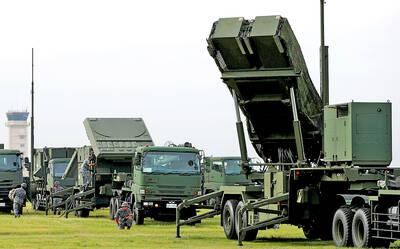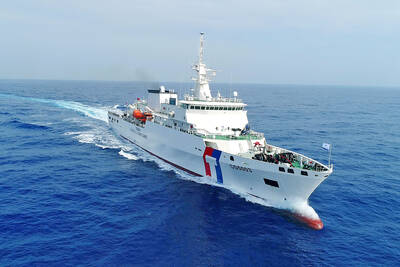Google Inc posted a 38 percent jump in first-quarter profit on a rebound in Web advertising, but its stock fell 5 percent as the company disappointed some investors accustomed to blowout results.
Investors were also caught off guard by the company’s announcement that CEO Eric Schmidt would no longer take part in quarterly earnings conference calls, as it aims to “streamline” the process.
Google said the decision should not be interpreted as having any other meaning about Schmidt’s role at the company.
Analysts said key indicators for the first quarter — including a 7 percent rise in average cost-per-click, the price that advertisers pay when Web surfers click their search ads — appeared strong, even if investors had hoped for more from a company that had beaten earnings forecasts in seven of the past eight quarters.
Net profit in the first quarter reached US$1.96 billion, or US$6.06 a share, up from US$1.42 billion, or US$4.49 a share, in the year-earlier period.
Excluding certain items, Google said it earned US$6.76 a share, beating the US$6.60 average forecast by analysts polled by Thomson Reuters I/B/E/S.
Google executives said the company experienced strong growth during the first quarter across the board, with improvements in paid search, display advertising and in its nascent mobile business.
“Large advertisers have come back in force versus last year,” Google chief financial officer Patrick Pichette said during the call.
Google provided few details about its business selling ads that appear on mobile phones, but said its Android smartphone software was available on 34 different devices on the market and that the number of software apps designed to run on Android phones had grown to 38,000.
Executives declined to say how many of the Nexus One smartphones — which Google sells directly to consumers on its Web site — have been sold since being introduced in January, but said the company was pleased with the phone’s “uptake.”
Google faces an increasing threat from iPhone-maker Apple Inc in the mobile advertising business.
Other long-term challenges also face Google as it tries to sustain its rapid growth, including increasing regulatory headaches and the company’s withdrawal from China in a row over censorship.
In an interview with Reuters, Pichette said Google still has a sales force in China catering to local advertisers, even though Google’s Chinese-language Web site is now based in Hong Kong.
“We have partners we can monetize in mainland China as well and we’ll continue to have them,” Pichette said.
Asked how advertising by Chinese companies has fared since Google moved its Chinese-language search site to Hong Kong, Pichette said he could not comment.
Google, which controls roughly two-thirds of the US search market, said revenue in the first quarter totaled US$6.77 billion, compared with US$5.51 billion in the year-ago period.
Net revenue, which excludes costs that Google pays to partner Web sites, was US$5.06 billion, up 2.2 percent from the seasonally strong fourth quarter and above analysts’ average estimate of US$4.95 billion.
Google said it increased its headcount by nearly 800 employees — the biggest increase in staff since the first quarter of 2008.
Pichette said the company would keep acquiring companies and hiring aggressively throughout the year.

MILITARY BOOST: The procurement was planned after Washington recommended that Taiwan increase its stock of air defense missiles, a defense official said yesterday Taiwan is planning to order an additional four PAC-3 MSE systems and up to 500 missiles in response to an increasing number of missile sites on China’s east coast, a defense official said yesterday. The official, who spoke on condition of anonymity, said that the proposed order would be placed using the defense procurement special budget, adding that about NT$1 trillion (US$32,88 billion) has been allocated for the budget. The proposed acquisition would include launchers, missiles, and a lower tier air and missile defense radar system, they said The procurement was planned after the US military recommended that Taiwan increase

POLITICAL AGENDA: Beijing’s cross-strait Mid-Autumn Festival events are part of a ‘cultural united front’ aimed at promoting unification with Taiwan, academics said Local authorities in China have been inviting Taiwanese to participate in cross-strait Mid-Autumn Festival celebrations centered around ideals of “family and nation,” a move Taiwanese academics said politicizes the holiday to promote the idea of “one family” across the Taiwan Strait. Sources said that China’s Fujian Provincial Government is organizing about 20 cross-strait-themed events in cities including Quanzhou, Nanping, Sanming and Zhangzhou. In Zhangzhou, a festival scheduled for Wednesday is to showcase Minnan-language songs and budaixi (布袋戲) glove puppetry to highlight cultural similarities between Taiwan and the region. Elsewhere, Jiangsu Province is hosting more than 10 similar celebrations in Taizhou, Changzhou, Suzhou,

TWO HEAVYWEIGHTS: Trump and Xi respect each other, are in a unique position to do something great, and they want to do that together, the US envoy to China said The administration of US President Donald Trump has told Chinese President Xi Jinping (習近平) “we don’t want any coercion, but we want [the Taiwan dispute] resolved peacefully,” US ambassador to China David Perdue said in a TV interview on Thursday. Trump “has said very clearly, we are not changing the ‘one China’ policy, we are going to adhere to the Taiwan Relations Act, the three communiques and the ‘six assurances’ that were done under [former US president Ronald] Reagan,” Perdue told Joe Kernen, cohost of CNBC’s Squawk Box. The act, the Three Joint Communiques and the “six assurances” are guidelines for Washington

DEEPENING TIES: The two are boosting cooperation in response to China’s coercive actions and have signed MOUs on search-and-rescue and anti-smuggling efforts Taiwan and Japan are moving to normalize joint coast guard training and considering the inclusion of other allies, the Japanese Yomiuri Shimbun reported yesterday. Both nations’ coast guards in June sent vessels to the seas south of the Sakishima Islands to conduct joint training, the report said, adding that it was the second joint maritime training exercise since the nations severed formal diplomatic ties in September 1972. Japan dispatched the Nagoya Coast Guard’s Mizuho, a 134m, 6,000-tonne patrol vessel which can carry a helicopter, while the Coast Guard Administration (CGA) sent the 126m, 4,000-tonne Yunlin, one of its largest vessels, the report